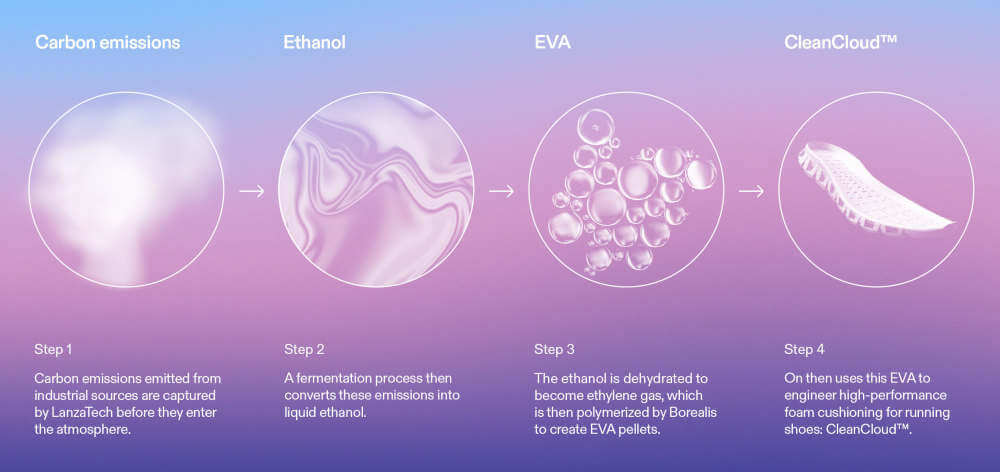![]()
Announcing CleanCloud™ – a new high-performance foam for running shoes, created using carbon emissions as a raw material.
Source: Turning carbon emissions into running shoes
CleanCloud™ is the next big step on our journey towards decoupling On’s growth from our carbon emissions. It follows the introduction of Cyclon, which offers fully recyclable performance running products via a subscription-only service. A Cyclon shoe produces 50% less CO2 than an average On shoe and 90% less waste in total.
On-Running is a relatively new company. When asked about their recent IPO, I explained that the company should have pulled a New Balance and remained private. I did not like their growth via expanded distribution. I still don’t like that the shoes are on the shelves at JD Sports and Shoe Palace, but slow growth isn’t something a publicly traded company can do. This post isn’t an analysis of On-Running’s business decisions. This post is to continue to a discussion started when Nike acquired RTFKT last week and adidas followed with the release of 30,000 NFTs less than 24 hours later, with Under Armour planning to follow suit on 12-21-2021.
From NFT News Today posted on April 17th, 2021:
But how much do the various platforms consume for NFTs on Ethereum?
To answer this question, we can observe the data collected with special tools, such as Carbon.fyi, which are updated a few weeks ago:
-
OpenSea produced over 67 million kg of CO2
-
Nifty Gateway has produced over 15 million kg of CO2
-
Rarible, it produced over 12 million kg of CO2
Mining crypto, and minting NFTs, is extremely power intensive. In this same article where these stats are found, there are alternatives given. Please take a moment to click through and read about EOS and other options. Below is a chart showing the breakdown of where CO2 derives. The chart is from 2016. NFTs and the marketplaces where they are sold are new. The irony in the introduction of NFTs is that they arrived during the pandemic, when the world saw a decrease in CO2 emissions because people were working from home and staying-in-place. The world had a chance to learn and implement new methods of work to slow the harm to the environment, but this hasn’t been the case.

https://ourworldindata.org/emissions-by-sector
Energy consumption is the greatest producer of CO2. The sneaker industry exists in every section of this chart. Every part of the production process of footwear and apparel contributes to the degradation of our environment. The brands have all announced initiatives to combat problems with carbon emissions. Nike and adidas have given their programs cool names like, Move to Zero and Futurecraft.Footprint or work with Parley of the Oceans. These programs talk about how Nike and adidas are building better products, but how do you build better products when you make the decision to mint and sell NFTs? On-Running has yet to announce in chasing of cool via the Metaverse and explaining how their CleanCloud will come to fruition could be a difficult task. The pictograph at the start of this post works, but I have an additional comparison.
TSR Ep. 8 | Part 1: Algix & Bloom Foam with CTO/Co-Founder Ryan W Hunt
On-Running Pulls a Bloom Foam Strategy
A few years ago I learned about Bloom Foam. I bought a pair of Merrell shoes utilizing the tech after I saw the co-founder of Algix, Ryan Hunt, at an Innovation Summit on sustainability. I wanted to learn about how the company was cleaning harmful algae blooms in bodies of water around the U.S. It was an eye opening experience. Visiting the facility helped to explain how their tech took the sludge produced by algae and turned it into granules which can be bonded with EVA (not the best thing, but better) to create midsoles and outsoles. If you are having a difficult time understanding how On is going to work with LanzaTech, watch the videos in the link above, and it’s the same concept, just with gas. If you remember your chemistry, you understand the states of matter. “The overall goal for CleanCloud™ is to exchange all bottom units from On shoes currently made from EVA with this new material. This would include the whole Cloud range and THE ROGER collection, as well as part of our active lifestyle assortment.”
Sneaker brands already contribute to footwear and apparel being overproduced (energy consumption and emissions throughout the spectrum) and dropped into landfills at the end of life of the product. When you consider On-Running has their Cyclon Program launching next year, and CleanCloud, maybe worrying about their current growth strategy shouldn’t be the concern. A company can pull back on distribution, but a company can’t quickly put into place a strategy to reduce their carbon footprint. That takes time, and ultimately it’s the type of work that endears the right consumer to a brand.
Check out CleanCloud and On Running using the link at the lead of this post.

